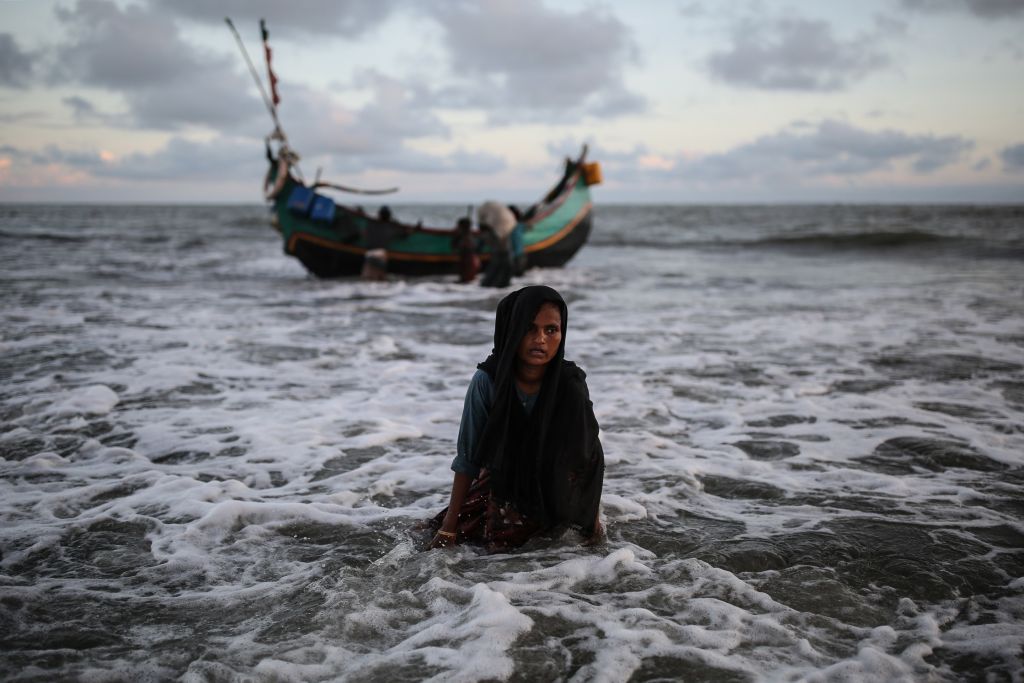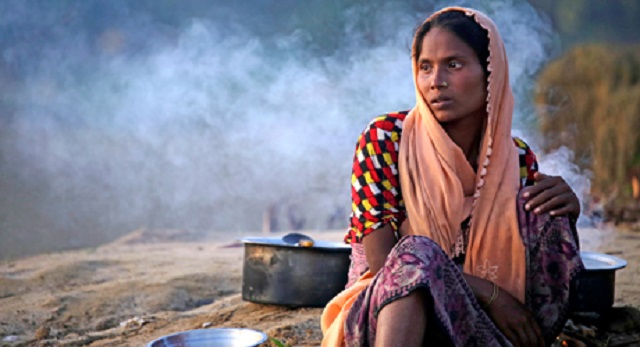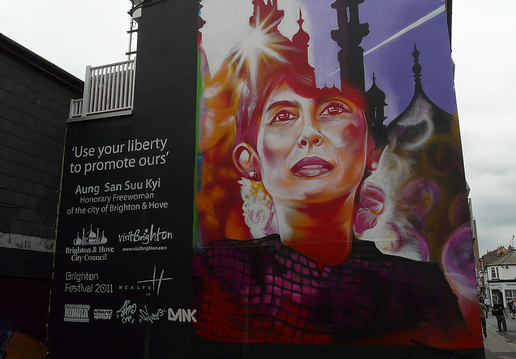They left a trail of ash: decoding the Arakan Army’s arson attacks in the Rohingya heartland

The village of Maw Ni Bill (Oe Thei) being burnt by arson attack on May 18th.
In the late evening of Friday 17 May 2024, Rohingya neighbourhoods in the town of Buthidaung in Myanmar’s Rakhine State were disturbed by an ominously familiar sight. Armed gunmen had come to their doors and ordered them to leave before the gunmen set their houses alight. If they refused, they were told, they would be burnt with their house.
As the Rohingya community fled to fields to the west, the gunmen torched their houses. By morning, most of what remained of Buthidaung had burnt to the ground. Buthidaung was the largest town to be burnt in a cycle of arson attacks throughout April and May, in which the junta and affiliated militants burnt approximately 2,400 structures, and the resistance-aligned Arakan Army retaliated by burning a further 8,500 structures across around 50 villages.
With communications in this area of Myanmar effectively cut off, with no independent media presence and with a desperate lack of supplies and food reaching the area, it is challenging to pin down specifics of what happened on 17 May. Using detailed analysis of satellite imagery, news reports, statements and open-source analysis of incidents on the ground, it is possible to provide crucial context to the violence that has occurred over the past weeks—enough to begin to verify the perpetrators.
This Strategist special report explains what happened that night and presents new satellite imagery analysis that reveals a systematic campaign of retaliatory arson that has occurred in the township since 24 April and continued until at least 21 May.

A map of the areas burnt in Buthidaung township between 24 April – 21 May.
The majority of these arson attacks occurred in uncontested Arakan Army territory with attacks on rural villages reportedly forcing many Rohingyas to flee from their burnt village to Buthidaung town itself prior to the arson attack there.
Following the genocidal anti-Rohingya violence of 2017, when the majority of Maungdaw Township’s Rohingya community was expelled or killed in a series of violent campaigns by the military, the township of Buthidaung in the Mayu River valley became home to the largest Rohingya community remaining in Myanmar, with over 150,000 Rohingya living in the township. Although the Rohingya community in Buthidaung is not as controlled or restricted as those living in internally displaced person camps across the rest of the state, the area is still subject to significant human rights abuses, including unreasonable restrictions on movement and access to services, along with a complete impunity for government forces in the area.
Following the outbreak of clashes between the Arakan Army and Burmese state forces in 2019, the township became more isolated and cut off from services and supplies. The township has been effectively under siege since the latest outbreak of violence during which the Arakan Army has captured much of Rakhine state from the junta.
With an increasingly dispossessed community, the junta has leveraged people’s desperation into actions deliberately calibrated to stoke communal tensions. In February and March 2024, junta authorities in Buthidaung town coerced and co-opted Rohingya residents to hold anti-Arakan Army demonstrations that were widely publicised in pro-junta media. These efforts were generally disregarded as a ploy to inflame communal tensions. However, the situation became more critical in March and April, as the junta started to enforce widespread conscription in an attempt to address its staggering losses on the battlefield over the preceding five months. Despite the Rohingya community long being denied citizenship or residency permits by government authorities, the junta sought conscripts from the Rohingya community using a mixture of false promises of citizenship along with threats and intimidation.
Despite having previously fought against the Burmese army, some Rohingya armed groups carried out forced recruitment into junta-aligned militias, including by abducting boys (reportedly some as young as 14) from Bangladesh refugee camps to return to Myanmar and fight.
Starting on 11 April, the military junta and Rohingya militants began burning down predominantly Buddhist and Hindu neighbourhoods of Buthidaung town to stoke further sectarian tensions. Over the following week, these attacks destroyed roughly 2,400 structures across 150 acres of Buthidaung town, with several of Buthidaung’s most densely populated neighbourhoods being entirely destroyed, including an office and pharmacy of the medical charity Doctors Without Borders.

Satellite Imagery of the town of Buthidaung, clearly showing the burn scars from Junta-led and Rohingya-assisted arson attacks that took place 11-17 April.
While these attacks were taking place in Buthidaung town through April, the Arakan Army was gaining full control on the other side of the Mayu River. It besieged and captured remaining junta military bases one-by-one.
And from 24 April, the Arakan Army began an arson campaign against Rohingya villages, retaliating against the whole Rohingya community for arson attacks in Buthidaung town. Over the following 10 days, it burnt 27 villages and hamlets on the eastern bank of the Mayu River, according to our analysis of satellite imagery.
Buthidaung town was, by all accounts, a chaotic place on 17 May, as conflict in the township was reaching its nadir. The Arakan Army had told residents that they would assault the town at 10am the next day, and ordered a general evacuation. However, by around 6pm on Friday afternoon, the group was overrunning four junta battalions on the western edge of town. According to statements by the Arakan Army, the remnants of these units then fled into the town, with local media reporting clashes at the entrance to Buthidaung town throughout Friday. This hastened the Arakan Army’s advance, and by 9:30pm much of the town was under their control, according to eyewitnesses. On the night of the arson attack, there was significant movement of Arakan Army and Burmese junta troops through the town, along with continued and hasty displacement of civilians.

Movements in and around the town of Buthidaung on 17 May , showing the Arakan Army in blue, Junta troops in red and civilians in purple.
Given the chaotic scene on the ground, and the immense communication restrictions in the area, independently and firmly establishing the perpetrator of this attack is challenging. However, satellite imagery analysis of arson attacks enables us to establish a clear pattern of retaliatory violence by the Arakan Army against Rohingya villages and neighbourhoods. The images show that as Arakan Army forces advanced across rural Buthidaung township in late April and May, they left a trail of rubble and ash as they burnt down Rohingya villages, seemingly indiscriminately.
That trail started on 24 April, around a week after the initial bout of junta-directed and Rohingya-committed arson in Buthidaung town ended. On that day, the village of Raza Berha (Nan Yar Kone), with around 100 homes, became the first Rohingya village torched on the Mayu River’s eastern bank. Satellite imagery from the next morning shows much of the northern part of the village destroyed. Over the next week, around a dozen villages would be burnt, including the large settlements of Kun Taing Ywar Gyi and Taung (Pale Taung).

Burnt villages of Kun Taing Ywar Gyi, Ah Nauk, Ah Shey, Fawrni Bashar, Da Bru Yaung, Tha Rat Kuni and Reza Berha on the eastern bank of the Mayu River in satellite imagery from May 13th.
The comprehensive destruction, completely burning all villages in this area of the township, strongly suggests that this has been a deliberate campaign of arson and that these towns were not merely damaged by airstrikes, artillery fire or columns of fleeing troops.
In a 4 May statement announcing their control over the entire eastern bank of the Mayu River, the Arakan Army provided some clarification regarding their territorial control over the area in the preceding months. They state that for much of 2024, Arakan Army troops had surrounded and blocked the 15th Military Operations Command HQ in the area, and that since around 20 April, there had been heavy clashes within the base itself before the Arakan Army seized it on 2 May. As early as the start of April, local media was reporting that every battalion in Buthidaung was besieged by the Arakan Army.
Accordingly, 4km away from the nearest battalion base, when Raza Berha village burnt in the last week of April, the only armed group with presence in this part of the countryside was the Arakan Army. Similarly, other villages burnt in the early days of this arson campaign were some distance from besieged junta bases.
Over the following weeks, as the Arakan Army captured the remaining besieged junta battalions one-by-one, a disturbing pattern emerged of nearby villages being burnt immediately following their capture.
- On 25 April, the 565th Light Infantry Battalion was captured and, within a week, the neighbouring Rohingya villages of Shawdawr Para and Hadimma Para were burnt.
- On 2 May, the 15th Military Operations Command HQ was captured, and that night the neighbouring Rohingya village of Da Bru Yaung was burnt.
- On 3 May, the 551st Light Infantry Battalion was captured and within three days the neighbouring Rohingya village of Setawr Para was burnt.
- On 13 May, the 353rd Light Infantry Battalion was captured and, the following night, the neighbouring Rohingya village of Na Khine Daung was burnt.
- On 18 May, the final Junta battalions with the Buthidaung Tactical Operations Command were captured, with the neighbouring villages of Thar Mai Khali, Myaung, Daing Net Ywar, Kyauk Hpyu Taung and Let Wea Det Pyin Shey all burnt over the next two days, along with nearby town of Buthidaung itself.
This pattern was not repeated, however, in villages near military bases that were captured prior to the junta-directed arson attacks in Buthidaung town in mid-April. The 564th Light Infantry Battalion HQ was the first in the township to fall to the Arakan Army, being captured on 5 April. None of the villages surrounding this military base were burnt following its capture. This provides further evidence that the recent spate of arson attacks was in direct retaliation to junta-orchestrated provocations of communal tension.

Preliminary mapping of burnt areas in Buthidaung, showing the neighbourhoods burnt in the mid-April junta-led arson attacks and the areas burnt on 18 May.
The village of Na Khing Daung serves as a useful case study providing insight into the timeline on the Arakan Army’s control of the area. Following the arson attack on Buthidaung town and its widespread condemnation, official propaganda channels from the Arakan Army released photos showing their troops caring for injured Rohingya civilians in Na Khing Daung on 14 May. As Arakan Army troops were capturing the neighbouring 353rd Light Infantry Battalion the previous day, fleeing junta troops opened fire at the village as they passed through, causing injuries among civilians, according to local media reporting. A video from the same date and previously released through official Arakan Army channels shows scores of Rohingya from Na Khing Daung who were detained by junta forces being released by Arakan Army troops.
These two videos show the Arakan Army in firm control of the village on 14 May, with junta forces that were previously nearby rapidly disintegrating and fleeing across the countryside. Satellite imagery from the early afternoon of that day shows fire beginning to consume the village, with houses along the main road through the village having already been burnt. These fires would continue overnight and into the next day until, by the next satellite pass, the entire Rohingya hamlet within the village was burnt to the ground.
Tellingly, the ethnically Daingnet (a predominantly buddhist ethnicity from northern Rakhine state numbering around 80,000 people) hamlet of the same village remained completely undamaged. A mosque in the Rohingya hamlet was burnt, while the monastery 200m away was spared.
The burning also continued in many villages following the complete capture of Buthidaung township by the Arakan Army, with around a dozen villages, mostly to the west and southwest of Buthidaung town being burnt down following the expulsion of all junta positions in the area.
Together, the satellite evidence clearly demonstrates a systematic pattern of arson attacks across much of Buthidaung township, both in areas under complete Arakan Army control, and in a manner suggestive of on-the-ground arson attacks as compared to damage from airstrikes or artillery.
Thankfully, it appears that there have been no reports of continued arson attacks in the area beyond 21 May. It is possible or even likely that the Arakan Army command has reacted to the attention the atrocities generated, and prevented their troops on the ground from committing further arson. However, this is not enough. The already vulnerable and dispossessed Rohingya community of Buthidaung is now languishing in even worse conditions than before, with some reports suggesting that up to 60 displaced people have died, largely as a result of a lack of clean drinking water.
The Arakan Army urgently needs to restore community relations in the Rohingya heartland of which it is rapidly seizing control. It faces an uphill climb given the extent of the recent violence in which it has played a significant part, but there is room for reconciliation, especially as Rakhine and Rohingya communities can point to a common enemy as the actor responsible for provoking sectarian tension and as a springboard for common reconciliation.
The Arakan Army must act with initiative and urgency by providing immediate aid and assistance to displaced and desperate communities. It should reach out to key Rohingya leaders in areas under its control and commit to treating the Rohingya community as brothers just like all other members of the Arakanese nation, and demonstrate this commitment. It should recognise that at the individual level, Rohingya militants coerced into fighting alongside the junta are victims of the junta and not targets for reprisals. It should call them ‘Rohingya’ instead of the variety of slurs it has used and that immediately demonstrates the Arakan Army’s hostility. It should also recognise the opportunity in both human capital and economic development that could be realised if the Arakan Army is able to reverse its course and foster community relations in northern Rakhine state that facilitates widespread repatriation of Rohingya citizens.
The national resistance organisations must make it clear, both privately and publicly, that such atrocities are unacceptable, and that if the Arakan Army wants a seat at the table in a future federalised and democratic Myanmar, it must treat all civilians under its control with dignity and respect. It should publicly name the Arakan Army as the perpetrator of these atrocities that it condemned. It should facilitate dialogue and reconciliation efforts between the Arakan Army and Rohingya community leaders both inside and outside of Burma.
International actors should continue to recognise that the military junta remains the biggest impediment to peace and stability in both Rakhine and Myanmar more broadly, and that this communal violence has been directly and deliberately provoked by them. Even over the last week, junta forces and affiliated militias cordoned off a village in Rakhine state before executing over 70 civilians and burning scores of houses. Any policy that seeks to restore a pre-coup status quo is misguided and counterproductive. Despite this outbreak of violence, the Arakan Army—should it reflect and evolve from these atrocities—is far more likely to transform into a responsible and reliable partner in the region than the military junta.




